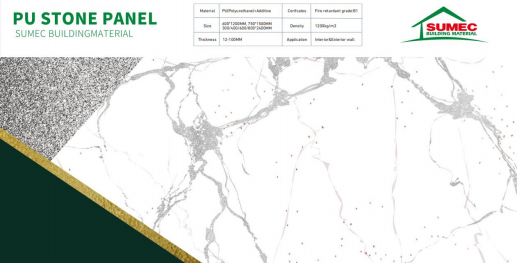As people's demands for architectural and living environments continue to rise, the array of building and decorative materials has been continuously expanding, with various new products emerging endlessly to meet diverse needs through their unique properties and characteristics. Among them is a type of panel called polyurethane stone-patterned panels. In recent years, this product has been gaining prominence in the building materials industry due to its unique advantages and is increasingly chosen by many designers and property owners.
To gain an in-depth understanding of this building material, you can explore it from two main aspects: its core components and appearance design. As a high-performance polymer material, polyurethane panels are widely used in multiple fields, including but not limited to color steel sandwich panels, central air conditioning systems, building wall materials, the construction of cold storage and refrigeration chambers, insulated box manufacturing, and chemical tank production. This panel is favored because it possesses excellent thermal insulation performance, while also excelling in weather resistance, corrosion resistance, and being lightweight yet high-strength. Polyurethane panels are available in various visual styles and can be customised to meet different application scenarios and design requirements, thereby satisfying a range of architectural aesthetic and functional needs.. As a new material, polyurethane has many characteristics that make it highly suitable for panel products. For example, it has a low thermal conductivity—only half that of extruded polystyrene boards—and is currently the insulation material with the lowest known thermal conductivity, making it an excellent thermal insulator. It also has waterproof properties; when made into waterproof wall panels, it can effectively prevent wall seepage. Moreover, polyurethane is heat-resistant and fire-retardant. After adding flame retardants, it becomes a difficult-to-burn self-extinguishing material that forms a carbonized layer on the surface of its foam when burned. This carbonized layer helps isolate the underlying foam and effectively prevents fire spread. Additionally, as a building material, it often needs to withstand external impacts, so the ability to maintain its original shape is crucial. It features strong anti-deformation capabilities, is not prone to cracking, and ensures stable and safe finishes.
Next, let’s examine the main technological process of polyurethane stone-patterned panels: First, a polyurethane high-pressure foaming machine mixes isocyanate and composite polyether in the polyurethane compound according to the precise ratio required by the product, after which the equipment discharges the mixture into a specific mold. These two raw materials expand and foam within the mold, ultimately forming the desired shape while retaining the mold’s color. The reason these building materials exhibit different surface patterns is that all molds are designed based on real stone textures, ensuring a highly realistic splicing effect.
The material’s diverse functionalities have enabled the expanding application scope of polyurethane stone-patterned panels. Coupled with their unique and realistic stone-finish effects, they can be found in many real-life scenarios. For example, when used on building exteriors, their rich variety of stone patterns and colors can give buildings distinct styles, creating unique visual effects that embody either quaint elegance or modern fashion. Their waterproof and windproof properties also effectively protect building walls and extend the overall service life of structures. Moving indoors, polyurethane stone-patterned panels are also used in interior wall decorations. Everyone has different understandings and preferences for interior styles, and sometimes different atmospheres are created within a single space. In particular, many people now pay close attention to feature wall designs during renovations. Designers or property owners can select matching panels according to the overall decoration style, and the realistic stone patterns can create excellent visual focal points.



